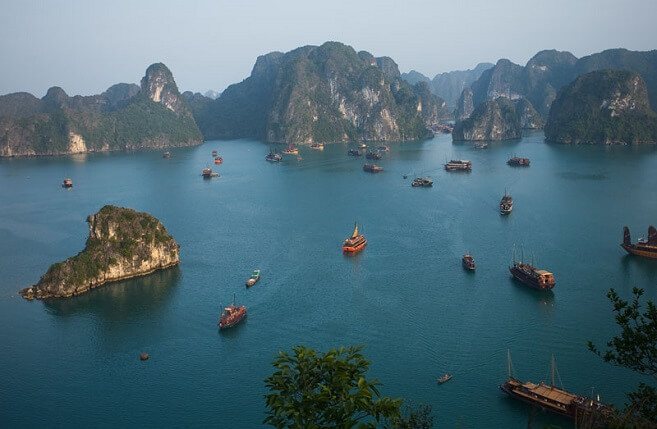Top 8 Parks and Green Spaces in Asia
Travelers pick 8 of the best in Asia.
by 8List | May 04, 2016
Parks can go from a tiny reprieve of vegetation in the city, to a huge expanse of lush forests, to manicured gardens with natural or man-made bodies of water. The hotel booking site Agoda.com recently rounded up a number of these parks and green spaces from all over Asia and held a survey for the best.
Here are the 8 that proved most memorable for travelers.

Average customer rating: 3.88 out of 5
In the middle of the sprawling Philippine capital, Rizal Park (also called Luneta Park) is both a beautiful escape from the traffic and noise, and a potent symbol of the country’s tumultuous history. It takes its name from national hero Jose Rizal, author and Filipino nationalist who was executed in 1896 for promoting sweeping social reforms during the Spanish colonial era. The 140 acre park is located next to the famous Intramuros walled city. It is one of the most popular spots in Manila for locals to picnic, exercise, and relax among gardens and greenery. Adjacent to the park are the Museum of the Filipino People, Department of Tourism, and the National Library. An impressive monument to Rizal stands on the western end. Trivia note—all road distances in the Philippines are measured from Kilometer Zero, just across the street from the Rizal Monument.

Average customer rating: 4 out of 5
The dense and beautiful Penang National Park is located in the northwest corner of Penang. Much like the island’s famous culinary scene, there are big rewards for a bit of exploration. Established in 2003 and just over 25 sq.km, it’s Malaysia’s smallest and youngest national park, and is packed with things to see and do. Two hiking trails snake through rugged forest landscapes, isolated beaches are great for a quick dip or a long nap, and those with quick trigger fingers can get some great pictures of monkeys, turtles, otters, and even dolphins. For a great view of the forest from a different angle, try the 250m long canopy suspended from the trees 15m above the ground.

Average customer rating: 4.12 out of 5
Established in 1962, the 2,100 sq.km Khao Yai National Park was Thailand’s first national park. Its location can’t be beat—only a few hours after leaving Bangkok one can be trekking through lush wilderness to a jungle waterfall. From its lowest point above sea level (100m) to its highest (1,350m), the park is home to a long list of sensitive and endangered fauna, from pythons to bears to elephants and even a famous lonely lost crocodile. An average daily temperature in the low 20’s Celsius also make it a great escape from lower, hotter areas. Many opt to rent a car or motorcycle and explore the park on their own time, but be sure to head to the visitor’s center for maps and tips before you head out.

Average customer rating: 4.17 out of 5
Located within sight of tourist magnet Ko Samui, Ang Thong National Marine Park encompasses 42 islands across 102 sq.km of deep blue ocean. Once a haven for pirates and smugglers, it was designated as a marine park in 1980 due to a fragile ecosystem that includes everything from turtles to monkeys to pigs. Organized boat trips (most often from Ko Samui or Ko Pha Ngan) are the best way to get here. Relax on beaches, snorkel among fish and coral, paddle around in a kayak, or explore trekking trails on some of the larger islands. Most tours include a trip to Ko Mae Ko, which offers a stunning view from its peak across the park’s entire expanse.

Average customer rating: 4.23 out of 5
Halong Bay is one of Vietnam’s most popular destinations, and carries the awards and badges to match its beauty. It is both a UNESCO World Heritage Site, and alongside the Cat Ba National Park, a Special National Landscape Site. The craggy, curving coastline boasts about 1,600 islands just offshore. Many with hiking trails, large caves, and vantage points that offer spectacular views across the ocean—especially during sunset. The most common method of taking it all in is on single- or multi-day boat tours on large junks. The 90 sq.km national park on Cat Ba Island is a must-visit, offering waterfalls, jungle, lakes, and dramatic cliffs, among other activities.

Average customer rating: 4.29 out of 5
This park in the middle of Osaka is the smallest on our list. It is the beauty and historical significance, not the size, that has captured the attention of visitors. Home to various official buildings since the 1400s, it was made a park in 1931. The complex boasts an open air concert hall and several athletic fields. The centerpiece is Osaka Castle, which sits atop imposing stone walls and covers 15 acres. Surrounding that are over 250 acres of finely manicured garden, including moats, walking paths and hundreds of cherry and apricot trees. Thirteen structures within the park—including gates, turrets, and the gun powder storehouse—have been designated Important Cultural Properties, providing a superb glimpse into Osaka’s history.

Average customer rating: 4.38 out of 5
Most of Taiwan’s cities line the west side of the island, but Taroko National Park is located on the eastern side, away from the cities. This makes it a great destination for nature lovers. Just over 900 sq.km in size, it features waterfalls, peaks, trekking trails and campgrounds. Unique to the other national parks on this list, is that a large part of the park can be seen via train as it passes down the island’s east coast. Scenic marble and limestone cliffs are highlighted by the Taroko Gorge, a dramatic gouge in the Earth spanned by narrow bridges and ringed by hiking trails and the occasional cliff-side temple. No need to aim your camera to get stunning pictures here.

Average customer rating: 4.39 out of 5
Hallasan National Park is both a UNESCO Biosphere Reserve and World Heritage Site. It is located on Jeju Island, South Korea’s southernmost province. The 153 sq.km park is famous for its dramatic geological features, among them Manjanggul Lava Tube (the world’s largest), Sunrise Peak, and several impressive caves. Adventure seekers can climb South Korea’s highest point, Mt. Halla, for great views and to see Baekrokdam Lake at the top. The visitor’s center is a great place to start. They can get you well acquainted with the park, including lectures, guided hikes, and classes for the kids.
This article was originally uploaded on 8List.ph.









